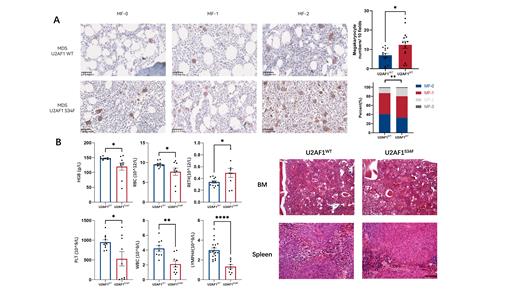Aims: Exploring the clinical and pathological characteristics of MDS patients with U2AF1 mutation and investigating the impact of mutation on hematopoietic stem and progenitor cells.
Methods: Nine hundred and eighty-nine consecutive subjects with MDS who underwent targeted next generation sequencing (NGS) from August 2016 to September 2022 were included in this study. Clinical and pathological characteristics were collected and analyzed. U2AF1 S34F retroviral murine model was used to evaluate changes of hematopoiesis in the bone marrow and spleen.
Results: Among the 989 MDS patients, U2AF1 mutation occurs in 23% of them. Within the subgroup of patients diagnosed with MDS with fibrosis (MDS-f) according to the updated WHO 2022 criteria, the frequency of U2AF1 mutation rose to 42%. Patients with U2AF1 mutation exhibited lower levels of hemoglobin and higher degrees of fibrosis, along with a significant increase in megakaryocyte counts in bone marrow biopsy and smear ( Figure A).
Our U2AF1 S34F retroviral murine model also had MDS-like phenotype with pancytopenia in the peripheral blood and the significantly increased proportion of LSK, ST-HSCs and MPPs in bone marrow and spleen. A notable finding was the significant increase in the proportion of megakaryocyte progenitor cells (MkP). HE staining and CD41 immunohistochemistry staining demonstrated a pronounced elevation and clustering of megakaryocytes both in bone marrow and spleen ( Figure B).
Conclusion: Our study suggested that U2AF1 S34F mutation enhancing megakaryocytic differentiation in vivo. This finding may be associated with specific clinically and pathologically features in patients, including a significant increase of megakaryocytes and higher fibrosis grades, it could be a promising therapeutic target in fibrosis.
Bing Li and Zhijian Xiao are Co-corresponding authors.
Disclosures
No relevant conflicts of interest to declare.


This feature is available to Subscribers Only
Sign In or Create an Account Close Modal